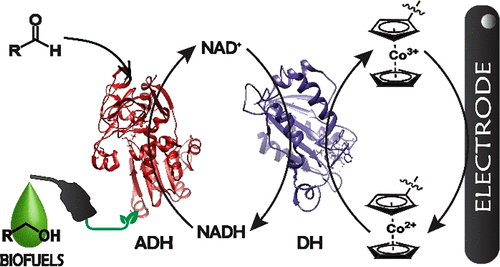当前位置:
X-MOL 学术
›
ACS Catal.
›
论文详情
Our official English website, www.x-mol.net, welcomes your
feedback! (Note: you will need to create a separate account there.)
Efficient NADH Regeneration by a Redox Polymer-Immobilized Enzymatic System
ACS Catalysis ( IF 11.3 ) Pub Date : 2019-05-06 00:00:00 , DOI: 10.1021/acscatal.9b00513 Mengwei Yuan 1 , Matthew J. Kummer 1 , Ross D. Milton 1 , Timothy Quah 1 , Shelley D. Minteer 1
ACS Catalysis ( IF 11.3 ) Pub Date : 2019-05-06 00:00:00 , DOI: 10.1021/acscatal.9b00513 Mengwei Yuan 1 , Matthew J. Kummer 1 , Ross D. Milton 1 , Timothy Quah 1 , Shelley D. Minteer 1
Affiliation

|
Given the high costs and stoichiometric amounts of reduced nicotinamide adenine dinucleotide (NADH) required by the many oxidoreductases used for organic synthesis and the pharmaceutical industry, there is a need for the efficient reductive regeneration of NADH from its oxidized form, NAD+. Bioelectrocatalytic methods for NADH regeneration involving diaphorase and a redox mediator have shown promise; however, strong reductive mediators needed for this system are scarce, generally unstable, and require downstream separation. The immobilization of diaphorase in cobaltocene-modified poly(allylamine) redox polymer is presented which is capable of producing bioactive 1,4-NADH with yields between 97% and 100%, faradaic efficiencies between 78% and 99%, and turnover frequencies between 2091 h–1 and 3680 h–1 over a range of temperatures spanning 20 to 60 °C. By using this system, methanol and propanol production by an NADH-dependent alcohol dehydrogenase were enhanced 7.1- and 5.2-fold, respectively, compared with a negative control. Finally, the efficiency of this approach coupled with its high operational stability (91% of the maximum activity after five experimental cycles) renders it among the most promising means of NADH regeneration yet developed.
中文翻译:

氧化还原聚合物固定化酶系统对NADH的高效再生
鉴于用于有机合成和制药业的许多氧化还原酶所需的高成本和化学计量的还原烟酰胺腺嘌呤二核苷酸(NADH),需要从其氧化形式NAD +有效还原NADH 。涉及心肌黄递酶和氧化还原介体的NADH再生的生物电催化方法已显示出前景。但是,该系统所需的强还原性介质很少,通常不稳定,需要下游分离。提出了将黄递黄酮酶固定在钴茂改性的聚(烯丙胺)氧化还原聚合物中,该聚合物能够生产生物活性的1,4-NADH,产率在97%至100%之间,法拉第效率在78%至99%之间,周转频率在2091年之间h –1在20至60°C的温度范围内为3680 h –1。通过使用该系统,与阴性对照相比,NADH依赖性醇脱氢酶对甲醇和丙醇的产量分别提高了7.1倍和5.2倍。最后,这种方法的效率及其高的操作稳定性(五个实验循环后最大活性的91%)使其成为尚未开发的最有希望的NADH再生方法之一。
更新日期:2019-05-06
中文翻译:

氧化还原聚合物固定化酶系统对NADH的高效再生
鉴于用于有机合成和制药业的许多氧化还原酶所需的高成本和化学计量的还原烟酰胺腺嘌呤二核苷酸(NADH),需要从其氧化形式NAD +有效还原NADH 。涉及心肌黄递酶和氧化还原介体的NADH再生的生物电催化方法已显示出前景。但是,该系统所需的强还原性介质很少,通常不稳定,需要下游分离。提出了将黄递黄酮酶固定在钴茂改性的聚(烯丙胺)氧化还原聚合物中,该聚合物能够生产生物活性的1,4-NADH,产率在97%至100%之间,法拉第效率在78%至99%之间,周转频率在2091年之间h –1在20至60°C的温度范围内为3680 h –1。通过使用该系统,与阴性对照相比,NADH依赖性醇脱氢酶对甲醇和丙醇的产量分别提高了7.1倍和5.2倍。最后,这种方法的效率及其高的操作稳定性(五个实验循环后最大活性的91%)使其成为尚未开发的最有希望的NADH再生方法之一。





















































 京公网安备 11010802027423号
京公网安备 11010802027423号